How can I get a ° (degree) character into a string?
- 50,140
- 28
- 121
- 140
- 15,152
- 31
- 85
- 111
-
1Please see [this answer](http://stackoverflow.com/a/37678518/4099593) if you are attempting to print the degree sign on a ***Windows*** system. – Bhargav Rao Jun 07 '16 at 12:32
8 Answers
This is the most coder-friendly version of specifying a Unicode character:
degree_sign = u'\N{DEGREE SIGN}'
Escape Sequence: \N{name}
Meaning: Character named name in the Unicode database
Reference: https://docs.python.org/3/reference/lexical_analysis.html#string-and-bytes-literals
Note:
"N" must be uppercase in the
\Nconstruct to avoid confusion with the\nnewline characterThe character name inside the curly braces can be any case
It's easier to remember the name of a character than its Unicode index. It's also more readable, ergo debugging-friendly. The character substitution happens at compile time, i.e. the .py[co] file will contain a constant for u'°':
>>> import dis
>>> c= compile('u"\N{DEGREE SIGN}"', '', 'eval')
>>> dis.dis(c)
1 0 LOAD_CONST 0 (u'\xb0')
3 RETURN_VALUE
>>> c.co_consts
(u'\xb0',)
>>> c= compile('u"\N{DEGREE SIGN}-\N{EMPTY SET}"', '', 'eval')
>>> c.co_consts
(u'\xb0-\u2205',)
>>> print c.co_consts[0]
°-∅
- 3,777
- 9
- 27
- 53
- 92,761
- 29
- 141
- 204
>>> u"\u00b0"
u'\xb0'
>>> print _
°
BTW, all I did was search "unicode degree" on Google. This brings up two results: "Degree sign U+00B0" and "Degree Celsius U+2103", which are actually different:
>>> u"\u2103"
u'\u2103'
>>> print _
℃
- 45,184
- 7
- 50
- 57
-
4
-
@SilentGhost: Well yeah, but I didn't remember the numpad code for ° and didn't feel like looking it up at the time. – JAB Jul 09 '10 at 18:30
-
1Who remembers numpad codes? :) [Compose key](https://en.wikipedia.org/wiki/Compose_key) sequences are a _lot_ easier to remember; degree is just Compose-o-o. Compose key is standard on X windows systems, but it's also available for Microsoft Windows; see the Wikipedia link. – PM 2Ring Jun 07 '16 at 12:55
Put this line at the top of your source
# -*- coding: utf-8 -*-
If your editor uses a different encoding, substitute for utf-8
Then you can include utf-8 characters directly in the source
- 295,403
- 53
- 369
- 502
-
1Assuming your editor does UTF-8. If your editor uses a different charset then indicate that instead. – Ignacio Vazquez-Abrams Jul 09 '10 at 19:19
just use \xb0 (in a string); python will convert it automatically
- 59,234
- 49
- 233
- 358
- 121
- 1
- 4
Above answers assume that UTF8 encoding can safely be used - this one is specifically targetted for Windows.
The Windows console normaly uses CP850 encoding and not utf-8, so if you try to use a source file utf8-encoded, you get those 2 (incorrect) characters ┬░ instead of a degree °.
Demonstration (using python 2.7 in a windows console):
deg = u'\xb0` # utf code for degree
print deg.encode('utf8')
effectively outputs ┬░.
Fix: just force the correct encoding (or better use unicode):
local_encoding = 'cp850' # adapt for other encodings
deg = u'\xb0'.encode(local_encoding)
print deg
or if you use a source file that explicitely defines an encoding:
# -*- coding: utf-8 -*-
local_encoding = 'cp850' # adapt for other encodings
print " The current temperature in the country/city you've entered is " + temp_in_county_or_city + "°C.".decode('utf8').encode(local_encoding)
- 143,923
- 11
- 122
- 252
Using python f-string, f"{var}", you can use:
theta = 45
print(f"Theta {theta}\N{DEGREE SIGN}.")
Output: Theta 45°.
*improving tzot answer
- 1,512
- 12
- 22
Special case: Sending a string to a 16x2 or 20x4 LCD (e.g. attached to a Raspberry Pi with I2C LCD display):
f"Outside Temp: {my_temp_variable}{chr(223)}"
- 245
- 3
- 9
